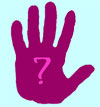After their early history, left-handers' circumstances did not improve. Lefty history ranged from accusations of witchcraft, to scientific examination. By the late 1800s, scientists began searching for explanations on how the human brain worked and began to theorize on why left-handedness existed.
Other history
From early history onward, the right-hand preference and enforcement has been very strong. There is even one theory using the sun to support right-handedness: when people in the northern countries faced south, they observed the sun moving from left to right. That movement came to be regarded as natural and proper, although this doesn't account for the point-of-view of people in the southern hemisphere!
We know that people were persecuted and killed for being left-handed. As we approach the recent past, we can see science try to explain handedness from a rational point of view. Benjamin Franklin even wrote an essay called "The Left Hand," in which he described its sad plight. Here, we'll cover the opposite ends of the spectrum to explain left-handedness: witchcraft and science.
- Witchcraft
- In Scotland, the idea of moving counterclockwise was called "widdershins," meaning "against the sun." If someone went around a building from right to left, they could be accused of witchcraft. This idea was used in the Salem witch trials in New England.
- The left hand was used to curse someone; it was also supposedly featured in ceremonies known as Black Mass or Witches' Sabbath, as the left hand was implemented where the right would be in Christian services.
- Marks or moles on the left side of a person's body were considered the mark of Satan, a sure sign for witch hunters, not to mention left-handedness itself.
- Joan of Arc has been depicted in some contemporary artworks to be left-handed. If true, it may have been a contributing factor to her being burned as a witch.
- Science
In the 1800's came the beginnings of scientific theories explaining left-handedness and brain lateralization. Most did not stand the test of time or investigation.
- One theory said that internal organs were asymmetrical, making the center of gravity for the body to the right. This arrangement gave better balance to the left foot, therefore building up muscles on the right side. Unfortunately, this theory doesn't account for left-handed people, unless their vital organs were located opposite.
- Thomas Carlyle's "sword and shield" theory: the shield was held in the left hand to protect the heart, so the right hand became dominant. This view didn't account for right-handedness before shields came into use.
- The scientific journal Mind published a theory in 1884 which held that mothers or nurses held babies in their right arms, thus causing the babies to use their own free right arms. But actually more mothers held their babies in their left arms, freeing their own right arms to use.
- The "Learned Handedness" theory stated that right-handedness was learned via pressures from school, culture, and society.
- In 1861, neurosurgeon Paul Broca determined through post-mortem a localized area on the left hemisphere that controlled the production of speech. This area is now called "Broca's Area." Broca also postulated "Broca's Rule," which stated that the hemisphere that controls speech is the opposite side to the person's handedness. This was a big discovery, and Broca's Rule held on into the 20th century, although ultimately it is not always true.
- In the late 1870's there was a rather large following for the ideas of the evangelical Charles Reade. His belief in the superiority of ambidexterity, using both hands equally well, ultimately resulted in the founding of the Ambidextral Culture Society by others. It began in England in 1903 and moved to America, and soon developed into an educational fad. Supportive articles were printed in journals of the time, but eventually people found that ambidexterity was quite difficult to attain. Research also indicated that right-handedness was probably innate, and not learned.
What progress, scientific or social, was made in the last century? Find out on the next page!
